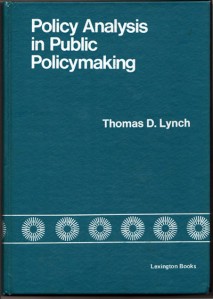Policy Analisys in Public Policymaking
Policy Analysis in Public Policy making
 Library of Congress Cataloging in Publication Data
Library of Congress Cataloging in Publication Data
Lynch, Thomas Dexter, 1942-
Policy analysis in public policy making.
Bibliography: p.
1. Transportation and state-United States. 2. Program budgeting-
United States. 3. Decision-making in public administration-Case studies.
HE206.2.L9 380.5’0973 74-26508
ISBN 0-669-97246-0
Copyright © 1975 by D.C. Heath and Company.
All rights reserved. No part of this publication may be reproduced or transmitted in any form or by any means, electronic or mechanical, including photocopy, recording, or any information storage or retrieval system, without the permission in writing from the publisher.
PREFACE.
This book attempts to clarify what can reasonably by expected of policy analysis as it relates to government decision-making. The scope is limited to the public policy making process is the United States federal government. The attempt to institutionalize policy analysis, called Planning-Programming-Budgeting (PPB), is the focus. The implementation of PPB in the federal government was one of the few attempts in the world to institutionalize policy analysis as part of the public policy making process.
“Public policy making” as a daily, inescapable fact of any government is not the subject here. Instead, the book is concerned with certain processes and considerations that precede decision making and shape its character. The emphasis is on the making rather than the policy.
In preparing this book, a great deal of careful effort went into assembling information from published sources, official government publications, unusual sources such as trade newsletters, internal government letters and memorandum, and interviews. The goal, particularly in chapters 2 through 5, was to understand fully the facts and circumstances associated with specific policy decisions, especially the role PPB was expected to play in policy making and the role it actually did play. If written source material was not adequate to explain the circumstances surrounding a policy decision, then interviews were used to supplement the written material.
The facts cite in Chapters 2 through 5 were documented whenever possible by written data, some of which were unpublished, but which can be inspected independently by anyone wishing to do so. Unpublished documentation in the form of internal government paper was used most often in Chapters 3 and 4, because the author was a minor participant in the events cited in those chapters. The author worked three years in the Urban Mass Transportation Administration as a program analyst in the Office of Program Planning. This day-to-day experience was helpful in assembling information and gaining insight into how decisions were being made. In a few instances, the author used himself as a source, but only in unusual circumstances where no other source of information was available.
Interviews were conducted over approximately as six-month period (January to June 1972), and each interview was carefully recorded. Most interviews were conducted during the launch period or after working hours. During the interviews, the author constantly sought to determine the correct chronology of events discussed in the interview, to cross-check “facts” stated in other interviews or in written material such as newspaper articles, to follow up leads from other sources, and to identify the interviewee’s particular biases. Most of the twenty interviews were conducted with U.S. Department of Transportation high-level career civil servants and Coast Guard officers who were intimately involved in the policy matters discussed. Brief notes were often taken during the interview, but not when the note-taking inhibited frank discussion. After each interview was completed, it was recorded in writing as fully as possible. In all cases, the interviewee was tool that he was being interviewed because of his intimate knowledge of the events associated with a given policy decision. In most cases, confidentially was pledged to protect the interviewees, therefore notes citing interviews normally do not identify the interviewees.
Chapters 1 and 2 present background information essential in terms of understanding PPB and policy analysis and the relationship of each to American administrative thinking. Chapters3, 4 and 5 present specific case examples of how public policy making actually took plane in three different United States Department of Transportation programs, The final Chapter discusses the role of policy analysis in public policy making.
Thomas D. Lynch
December 7, 1974
